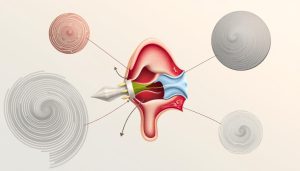Neck discomfort can really get in the way of your day. It affects your work and even your sleep. Many people are looking for ways to release tension in their neck.
This guide will show you quick relief for neck tension. You’ll find simple steps you can start using right away. Whether you’re at work, getting ready for bed, or trying to avoid neck pain, we’ve got you covered.
We’ll share easy and effective ways to handle neck tension. You’ll learn techniques and changes to make in your life. Say goodbye to neck pain and enjoy moving freely again.
Understanding Neck Tension: Causes and Symptoms
Neck tension is a common issue with many causes. Knowing what causes it and its symptoms is key to managing it. This part dives deep into the causes and signs of neck discomfort.
Common Causes of Neck Tension
Neck stiffness triggers often come from our daily lives and surroundings. Poor posture and long sitting times can strain neck muscles. Stress also tightens muscles, leading to pain.
Carrying heavy loads or doing repetitive tasks can put too much pressure on the neck. This can cause serious discomfort.
Recognizing the Symptoms of Neck Tension
The signs of neck tension vary, from mild to severe pain. You might feel a constant ache, muscle tightness, or trouble moving your head. Sometimes, the pain spreads to the shoulders or causes headaches.
Being aware of these symptoms helps you act fast to ease the discomfort. It also encourages better posture and stress management to avoid future issues.
Knowing the causes and symptoms of neck tension is the first step to relief. It helps in adopting healthier habits to prevent future problems.
Neck Tension Release Techniques for Immediate Relief
Many people deal with neck pain from daily activities. Using neck tension release techniques can give immediate relief for neck pain. This makes it easier to move and feel more comfortable.
Gentle Neck Rolls and Stretches
Gentle neck rolls and stretches are key to easing tension. They help loosen muscles, boost blood flow, and cut down on neck stiffness. Begin with slow, circular motions and increase the range as you get more comfortable. Always avoid sudden movements to avoid straining your neck further.
Heat Therapy: When and How to Apply
Heat therapy for tension in the neck is a great way to relax muscles and ease pain. A warm towel or heating pad on the neck can greatly reduce discomfort. Remember to use heat therapy safely, keeping each session to 15-20 minutes to prevent burns.

| Technique | Benefits | Duration |
|---|---|---|
| Gentle Neck Rolls | Improves flexibility and blood circulation | 5-10 Minutes |
| Neck Stretches | Alleviates stiffness and tension | 5-10 Minutes |
| Heat Therapy | Relaxes muscles and reduces pain | 15-20 Minutes |
Stretching Exercises for Neck Tension
Adding stretching exercises for neck tension to your daily routine can help a lot. They make your neck feel better and move easier. Fitness experts often suggest these stretches because they help with stiffness and stress.
Basic Neck Stretches You Can do Anywhere
Doing basic neck stretches is easy and free. You can do neck rolls, tilts, and extensions anywhere, without any special gear. Here are a few:
- Neck Side Stretch – lowers tension by targeting the side muscles of your neck.
- Back Neck Stretch – helps in reducing stiffness along the back of your neck.
- Forward Neck Stretch – alleviates tension by stretching the neck muscles in front.
The Importance of Consistency in Stretching
Regular stretching is good for everyone, but it’s even more important for those who sit a lot. Studies show that stretching often can make your neck more flexible. It also helps prevent injuries.
| Stretch | Frequency | Benefits |
|---|---|---|
| Neck Side Stretch | Daily | Reduces lateral neck tension |
| Back Neck Stretch | 2-3 times a week | Enhances cervical spine flexibility |
| Forward Neck Stretch | Daily | Relieves anterior neck muscle stiffness |
By making stretching exercises for neck tension a regular part of your life, you can feel better now and avoid problems later. Remember, sticking with it is what really matters.
Self-Massage for Neck Tension Relief
Neck tension can be really tough to deal with. But, self-massage for neck tension relief is a simple fix you can do at home or work. This guide shows you easy ways to ease neck pain through DIY neck tension alleviation.
Self-massage works on the neck muscles. It helps by boosting blood flow and easing muscle tightness. Just a few minutes a day can make a big difference in how you feel.
- Begin by gently pressing with your fingertips at the base of your skull. Move down the sides and back of your neck slowly.
- Use a circular motion to massage deeper tissues. Adjust the pressure to what feels right for you.
- Pay special attention to tight spots. Press them gently but firmly for a few seconds, then release and move on.
Stick to these steps regularly to get the most benefits. Doing self-massage often can help prevent neck pain in the future.
| Technique | Description | Recommended Duration |
|---|---|---|
| Fingertip Press | Gentle pressing using fingertips at various points | 1-2 minutes |
| Circular Motions | Circular massage movements with fingers or palms | 3-5 minutes |
| Pressure Points | Focused pressure on specific tender spots | 20-30 seconds per point |
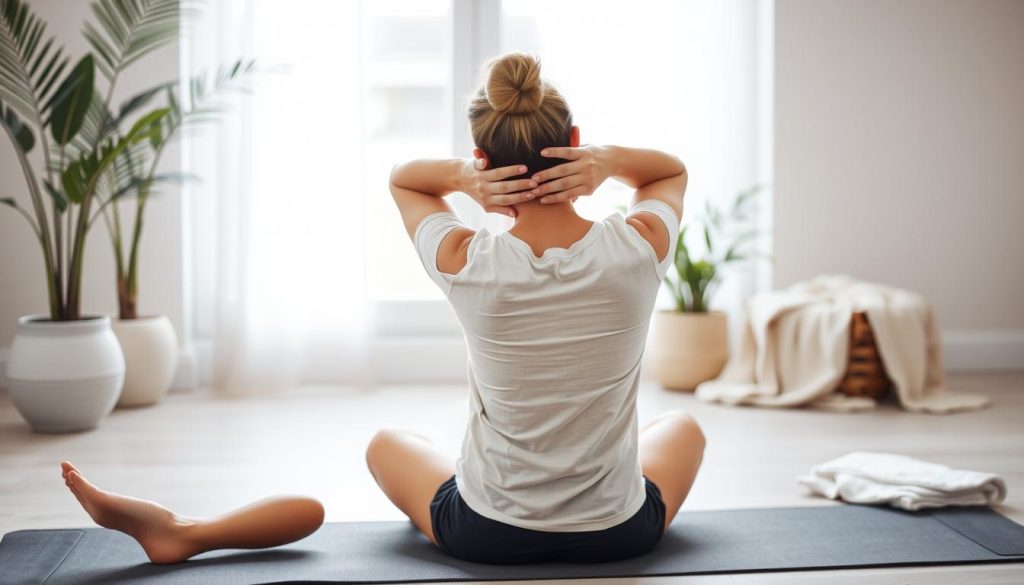
Adding self-massage for neck tension relief to your daily routine is a powerful move for your health. It gives you quick relief and helps keep your neck flexible and strong.
Relaxation Techniques for Alleviating Neck Discomfort
Adding relaxation techniques to your daily life can help reduce neck tension. This section looks at deep breathing, mindfulness, and meditation to ease neck pain.
Deep Breathing Exercises to Reduce Stress
Deep breathing exercises can lower muscle tension, including in the neck. By focusing on slow, deep breaths, you can reduce stress. This leads to a relaxation response.
It’s key to breathe deeply into your abdomen, not just your chest. This way, you get the most stress relief.
Mindfulness and Meditation Practices
Mindfulness and meditation are key for both mental and physical health. They help you observe your experiences without judgment. Regular meditation improves focus and reduces nerve tension.
These practices promote relaxation and better body awareness. They’re great for easing neck tension by relaxing all muscles.
Adding mindfulness and meditation to your day helps with neck tension and overall health. It also improves stress management.
Using these relaxation techniques can help manage stress and improve physical comfort. Stress-reducing exercises and mindfulness can lead to lasting relief from neck pain.
Yoga for Neck Tension Release
Yoga can be a game-changer for neck tension. It offers specific yoga poses for neck relief. Adding a yoga daily routine can keep you healthy for good.
Yoga Poses Specific for Neck Relief
Yoga poses like Cow Face Pose stretch the neck muscles gently. Extended Triangle Pose helps stretch the sides of the neck. These poses relax the neck and improve blood flow.
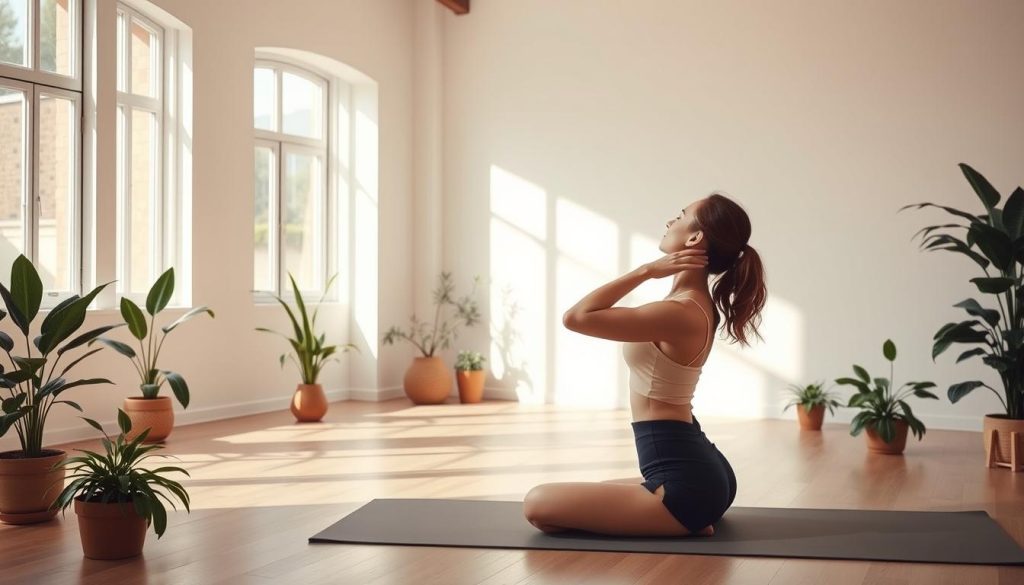
Incorporating Yoga into Your Daily Routine
Adding yoga to your day might seem hard, but it’s worth it. Just 10 minutes in the morning or evening can help. Regular yoga not only eases neck pain but also keeps your neck healthy over time.
For more tips on keeping up with yoga, check out holistic wellness routines. They help reduce neck strain and improve your posture.
How to Release Tension in Neck with Natural Remedies
Many people are now using natural remedies for neck tension and herbal neck tension relief. These methods are gentle and often have fewer side effects than medicines. Let’s explore some effective natural and herbal remedies for a tense neck.
Essential Oils: Essential oils like peppermint and lavender are known for their pain-relieving and muscle relaxing effects. You can apply a diluted version of these oils to your neck to ease tension.
Herbal Compresses: You can make compresses with herbs like chamomile, lavender, and rosemary. Soak a towel in hot water infused with these herbs and apply it to your neck for relief.
Dietary Supplements: Supplements like magnesium and omega-3 fatty acids are good for muscle health and reducing inflammation. Magnesium, in particular, helps relax muscles and is important for preventing muscle tension.
- Start with diluted essential oils applied directly to the neck.
- Use herbal compresses made from anti-inflammatory herbs.
- Incorporate dietary supplements like magnesium into your daily routine.
Using these herbal neck tension relief methods can help with current discomfort and prevent future issues. Always talk to a healthcare provider before trying new treatments to make sure they’re safe for you.
Adding these natural remedies to your daily routine can greatly improve neck tension and overall health. Whether it’s through oils, compresses, or supplements, each method is a sustainable and effective way to manage neck health.
Optimizing Your Work Environment to Prevent Neck Tension
Creating a workspace that promotes neck health is easy. It doesn’t need a lot of effort or money. Knowing about ergonomic desks, correct screen placement, and strategies to prevent neck tension can greatly improve your comfort and health.
Proper Desk and Chair Ergonomics
An ergonomic desk setup is key to good posture and avoiding neck strain. Your chair should support your spine’s natural curve. Your knees should be at a 90-degree angle, and your feet should be flat on the floor.
The desk height should match your elbows when you’re sitting comfortably. Keeping your wrists straight while typing also helps reduce strain.
Balanced Screen Placement to Avoid Strain
For neck health, place your monitor at eye level and about an arm’s length away. This avoids tilting your head or leaning forward, which can harm your neck. Using a monitor stand or adjustable desk can help get the screen at the right height and distance.
- Avoid glare by positioning your screen away from direct light sources.
- Adjust the screen brightness and contrast to comfortable levels to reduce eye strain.
- Ensure that the top of your computer screen is at or slightly below eye level.
Regularly updating your work environment with these ergonomic improvements is key. It helps prevent neck tension and boosts productivity. Make sure to adjust your workspace to fit your body’s needs. Try to alternate between sitting and standing, and take short breaks to stretch and relieve tension.
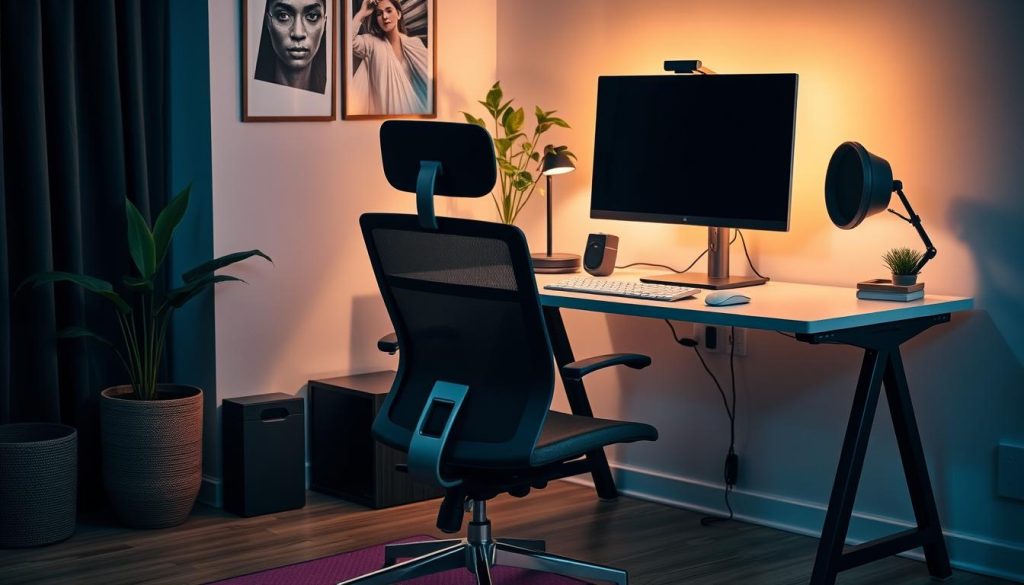
Neck Tension Relief Tips for a Better Night’s Sleep
Finding ways to ease neck tension for sleep can greatly improve your rest. To tackle sleeping with neck tension, it’s important to pick the right sleep gear and habits.
Start by checking your sleep space. Your mattress should be supportive yet comfy, keeping your spine straight. The pillow is key for neck tension relief for sleep. It should be the right height to keep your neck straight, without bending it up or down.
- Choose a pillow that fits the curve of your neck; memory foam or a firm pillow is best.
- Think about using a body pillow for more support and to stop you from sleeping on your stomach, which can make neck tension worse.
It’s also vital to pick the right sleeping position to ease neck tension for sleep. Sleeping on your back or side is best. These positions help keep your spine and neck aligned and reduce pressure.
| Sleeping Position | Benefits |
|---|---|
| Back | Keeps spine and neck aligned and reduces tension |
| Side | Prevents misalignment and relieves pressure on the neck |
Adding relaxation techniques before bed can also boost your sleep quality with neck tension. Gentle stretches or meditation can relax your muscles and calm your mind, preparing you for a good night’s sleep.
Lastly, sticking to these habits is essential. Regular sleep times, a sleep-friendly bedroom, and an ergonomic sleep setup all help fight nightly neck tension and better sleep.
Lifestyle Changes to Maintain a Healthy Neck
Keeping your neck healthy is more than just stretching and pain relief. It’s about making lifestyle changes. This includes exercising for neck health and eating right to reduce muscle tension. Let’s explore how certain exercises and foods can help your neck.
Importance of Regular Exercise on Neck Health
Exercise is key to strong neck muscles and better mobility. It also helps prevent injuries. By doing neck-focused exercises, you can ease pain and avoid more strain. Here are some exercises to add to your routine:
- Neck stretches, such as the forward and lateral neck flexion, to increase flexibility.
- Shoulder rolls and scapula shrugs to relieve upper body tension and stress.
- Strength-building exercises like the wall push-ups to fortify neck supporting muscles.
Nutritional Considerations for Muscle Health
Good nutrition is vital for muscle health and can help with neck tension. Muscles need the right nutrients to work well and heal.
| Nutrient | Benefits | Sources |
|---|---|---|
| Magnesium | Reduces muscle tension, alleviates stress | Pumpkin seeds, spinach, and almonds |
| Omega-3 Fatty Acids | Decreases inflammation in muscles | Fatty fish such as salmon and flax seeds |
| Calcium | Essential for muscle contraction and relaxation | Dairy products, leafy greens, and fortified cereals |
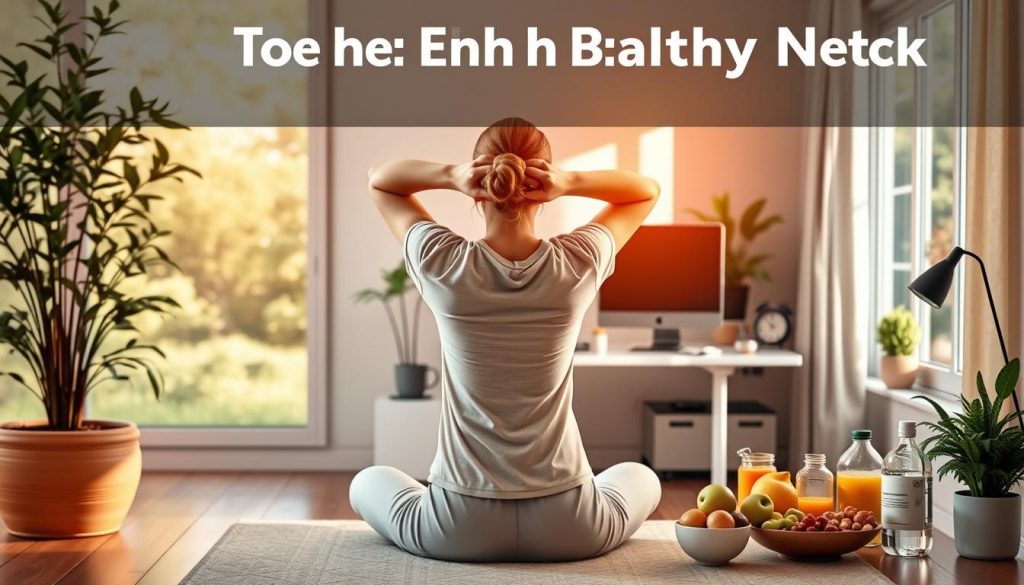
By adding specific exercises and healthy foods to your day, you can keep your neck muscles healthy. This not only helps your neck but also supports your whole spine.
When to Seek Professional Help for Neck Tension
Occasional neck tension is common and can be managed at home. But, there are times when you need professional help for neck tension. Knowing when to seek help is key to avoiding bigger problems and getting the right medical advice for neck issues.
If neck pain lasts for days without getting better, it’s time to see a doctor. Chronic pain often means there’s something serious going on. Also, if pain is so bad it stops you from doing everyday things, a pro can find the cause and fix it.
- Sudden severe pain
- Pain that radiates down arms or legs
- Weakness in the arms or legs
- Headaches accompanying neck pain
Also, numbness or tingling in arms, legs, or shoulders means nerves might be hurt. This is a sign you need medical advice for neck issues right away. If neck pain comes from an injury, like a car crash or fall, you must get professional help for neck tension. This is to check for broken bones or other serious injuries.
Knowing when to go to the doctor and understanding how serious your symptoms are can make a big difference. Regular check-ups and following treatment plans can help you get better faster.
Prevent Neck Tension Through Posture Awareness
Keeping your posture right is key to prevent neck tension. It’s about knowing what good posture is and making it part of your day. Here’s how to do it:
- Align your ears with your shoulders: This keeps your neck and spine straight, easing tension.
- Avoid slumping: Slouching adds weight to your neck, making it hurt more.
- Adjust your screen height: Make sure your screen is at eye level to avoid bending your head.
- Take frequent breaks: Get up and move every 30 minutes to release tension.
Changing how you sit and stand can really help your neck. Let’s look at how daily tasks can be done better:
| Activity | Poor Posture | Improved Posture |
|---|---|---|
| Working at a desk | Leaning forward | Sitting back in the chair with lumbar support |
| Watching TV | Slouching on the couch | Sitting with back straight and supported |
| Driving | Reaching too far for wheel | Adjusting seat for easy reach and good back support |
By paying attention to your posture and making these changes, you can prevent neck tension. This also helps your whole spine stay healthy. Making these habits can greatly improve your neck pain, making life more comfortable.
Summary of Quick Relief Techniques for Neck Tension
In this article, we’ve looked at many ways to ease neck pain. We’ve talked about simple stretches you can do at your desk and the calming effect of self-massage. We’ve also covered gentle neck rolls, using heat, and stretching exercises to fight neck tension.
Yoga and relaxation methods like deep breathing and meditation help with neck pain and stress. Making sure your workspace is set up right and getting enough sleep are also key. Eating right and exercising can help keep your neck muscles strong and relaxed.
We believe in treating neck pain in a complete way. Using these quick fixes regularly can help you feel better and prevent future pain. If your neck pain doesn’t go away, it’s important to see a doctor to keep your health safe.
FAQ
Q: What common factors lead to neck tension?
A: Poor posture, stress, and overusing neck muscles are common causes. Staying in one position for too long, like looking at phones or computers, also contributes.
Q: How can I quickly alleviate neck tension?
A: For quick relief, try gentle neck rolls and stretching exercises. Applying heat and self-massage can also help. Make sure your work area is set up ergonomically.
Q: Can stretching exercises reduce neck tension?
A: Yes, stretching exercises for the neck can help. Doing them regularly is key to seeing results.
Q: What self-massage techniques are effective for neck tension relief?
A: Use your fingers to apply gentle pressure to sore spots. Massage in a circular motion. Tools like massage balls or foam rollers can also be helpful.
Q: Can relaxation techniques help with neck discomfort?
A: Absolutely. Deep breathing, mindfulness, and meditation can reduce stress. This helps with neck tension and promotes relaxation.
Q: Are there any yoga poses that can help release tension in the neck?
A: Yes, poses like Child’s Pose and Cat-Cow are great for the neck. Adding them to your daily routine can offer ongoing relief.
Q: What are some natural remedies for neck tension?
A: Try essential oils like peppermint or lavender. Herbal compresses and anti-inflammatory teas, like ginger or turmeric, can also help.
Q: How can I prevent neck tension while working?
A: Keep your desk and chair ergonomically set up. Make sure your screen is at eye level. Take breaks to stretch and adjust your posture.
Q: What are some tips for relieving neck tension for better sleep?
A: Choose a pillow that supports your neck’s natural curve. Avoid sleeping on your stomach. Try to sleep in a way that keeps your spine aligned.
Q: How does regular exercise and nutrition affect neck health?
A: Exercise strengthens neck muscles and improves flexibility. It also helps reduce stress. Eating right keeps muscles healthy and manages inflammation.
Q: When should I seek professional help for neck tension?
A: If your neck pain is severe, lasts a long time, or comes with headaches, tingling, or numbness, seek help. Also, if it affects your daily activities.
Q: How can posture awareness prevent neck tension?
A: Being mindful of your posture can reduce neck muscle strain. This prevents tension from building up.
Q: Can you summarize the key techniques for quick relief from neck tension?
A: Key techniques include neck rolls, stretching, and applying heat. Self-massage, ergonomic work setup, relaxation exercises, yoga, and good sleep posture are also important.











